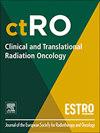缓解性快速适应性头颈部肿瘤四针放射治疗(PEAQ-RT)
IF 2.7
3区 医学
Q3 ONCOLOGY
引用次数: 0
摘要
目的/目的四次放射治疗(QS-RT)是头颈癌姑息治疗不可或缺的一部分,但多次ct模拟QS-RT周期可能给患者带来负担。我们评估了在线自适应放疗(ART)工作流程(PEAQ-RT)消除QS-RT中额外的CT模拟和减少治疗相关负担的能力。材料/方法10例头颈部恶性肿瘤患者被纳入这项前瞻性研究,接受长达三个周期的QS-RT,每个周期包括四个部分,350 cGy,每天两次,每周期总剂量为1400 cGy。QS-RT最多可以提供三个周期,间隔三到四周。患者进行标准CT模拟,模拟方案作为第一个QS-RT周期的治疗方案。在随后的QS-RT周期中,患者通过机构在线ART协议直接进行适应性治疗。可行性定义为在至少80%的尝试适应分数中完成此快速自适应QS-RT工作流。结果入选患者10例,年龄56 ~ 89岁。8名患者接受了第二周期的QS-RT, 4名患者接受了第三周期的QS-RT。PEAQ-RT工作流程在接受至少一个适应周期的87.5%(7/8)患者中是可行的,在86%(12/14)尝试适应部分中是可行的。对于第二个和第三个周期,适应性处理的平均总工作时间为28分钟(14-38)。使用在线自适应解决了所有违反约束的问题。PEAQ-RT工作流程通过额外的QS-RT周期消除了2次(范围:0-2)模拟访问的中位数。这使得平均路程节省了50.8英里(40.6-848英里),平均每位患者的路程减少了3.5小时。peaq - rt支持QS-RT,同时消除了后续周期额外CT模拟预约的需要。本文章由计算机程序翻译,如有差异,请以英文原文为准。
Palliative expeditiously adaptive quad shot radiotherapy for head and neck cancers (PEAQ-RT)
Purpose/objective
Quad shot radiotherapy (QS-RT) is integral to head and neck cancer palliative care, but multiple CT-simulations for QS-RT cycles can be burdensome for patients. We evaluated the ability of an online adaptive radiotherapy (ART) workflow (PEAQ-RT) to eliminate extra CT simulations in QS-RT and reduce treatment related burdens.
Materials/methods
Ten patients with head and neck malignancies were enrolled in this prospective study receiving QS-RT for up to three cycles, each comprising four fractions of 350 cGy delivered twice daily, with a total dose of 1400 cGy per cycle. QS-RT could be delivered up to three cycles, spaced three to four weeks apart. Patients underwent standard CT simulation, and the simulation plan served as the treatment plan for the first QS-RT cycle. For subsequent QS-RT cycles, patients proceeded directly to adaptive treatment via institutional online ART protocol. Feasibility was defined as completing this expedited adaptive QS-RT workflow in at least 80 % of attempted adapted fractions.
Results
Ten patients aged 56–89 were enrolled. Eight patients received a second cycle of QS-RT and four patients received a third cycle. PEAQ-RT workflow was feasible in 87.5% (7/8) of patients who received at least one adapted cycle and was feasible in 86% (12/14) of attempted adapted fractions. For the second and third cycles, average total workflow time for the adaptive treatments was 28 min (14–38). All constraint violations were resolved with the use of online adaptation. The PEAQ-RT workflow eliminated a median of 2 (range: 0–2) simulation visits with additional QS-RT cycles. This resulted in a median travel distance savings of 50.8 miles (range: 40.6–848 miles) and a median reduction of 3.5 h in travel time per patient.
Conclusion
PEAQ-RT enabled QS-RT while eliminating the need for additional CT simulation appointments for subsequent cycles.
求助全文
通过发布文献求助,成功后即可免费获取论文全文。
去求助
来源期刊

Clinical and Translational Radiation Oncology
Medicine-Radiology, Nuclear Medicine and Imaging
CiteScore
5.30
自引率
3.20%
发文量
114
审稿时长
40 days
 求助内容:
求助内容: 应助结果提醒方式:
应助结果提醒方式:


